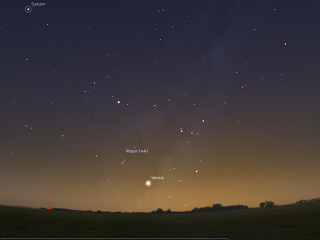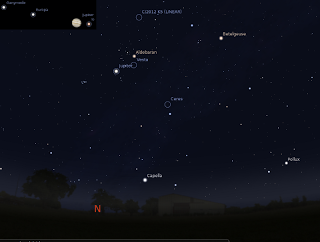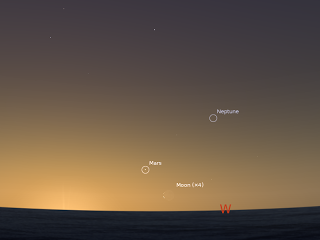

| Visitors Now: | |
| Total Visits: | |
| Total Stories: |

| Story Views | |
| Now: | |
| Last Hour: | |
| Last 24 Hours: | |
| Total: | |
The Sky This Week – Thursday January 10 to Thursday January 17
The New Moon is Saturday January 12. Jupiter is prominent in the evening sky. Saturn is visible high in the morning sky. Venus is low on the horizon and is visited by the crescent Moon on the 10th. Comet C/2012 K5 visible in telescopes in the northern sky.
Morning sky on Thursday January 10 looking east as seen from Adelaide at 5:30 am local daylight saving time in South Australia. The thin crescent Moon is close to Venus. Similar views will be seen elsewhere at the equivalent local time (click to embiggen).
The New Moon is Saturday January 12.
Bright white Venus is now quite low above the eastern horizon, and hard to see from cluttered horizons. Venus looks like a waxing Moon when seen through even a small telescope.
Venus starts the week in the constellation of Ophiuchus, and ends it in Sagittarius.
On the 10th Venus is close to the crescent Moon.
Saturn is now readily visible above the north-eastern horizon before dawn. Saturn climbs higher in the morning sky, becoming easier to see in the morning sky. It should be high enough to be wothwhile in a small telescope. Saturn is in the constellation of Libra.
Mercury is lost in the twilight.
Evening sky looking North as seen from Adelaide at 22:00 pm local daylight saving time on Saturday, January 12. The inset shows Jupiter’s Moons at this time. The location of comet C/2012K5 is indicated. Similar views will be seen elsewhere at the equivalent local time. Click to embiggen.
Jupiter is visible for most of the night, and is the brightest object in the evening sky. Despite opposition having just passed on the December the 3rd, Jupiter is prominent in the north-eastern early evening sky, being quite visible in the twilight. Jupiter is below the Hyades, near the red star Aldebaran. Jupiter remains near Aldebaran during the week, making it look as if the Bull has two eyes.
Jupiter, Aldebaran and the white star Rigel in Orion form a long line in the sky. With the Pleiades cluster and the constellation of Orion close by, this is a beautiful sight.
Jupiter is easily seen in the late evening sky, rising around 5:00 pm local daylight saving time and is highest in the north by 10:30 pm. Now is a perfect time to observe Jupiter with a telescope of any size in the evening. Jupiters’ Moons are easily seen in binoculars, and can be followed from night to night changing position. On the evening of Monday January 14 ay 9:000 pm local daylight savings time in the astern and central states, Io has a shadow transit and Ganymede appears from being occulted.
Comet C/2012 K5 LINEAR is a nice little comet that is now visible in Australian skies to the north.It has faded somewhat, and is now only visible in a telescope. See here for a spotting chart suitable for small telescopes. Roger Powell has a nice image of the comet here.
Evening twilight sky looking west as seen from Adelaide at 21:00 pm local daylight saving time on Sunday, January 13. The location of mars and the thin crescent Moon are shown. Similar views will be seen elsewhere at the equivalent local time. Click to embiggen.
Mars is lost in the twilight, but on the 13th is an opportunity to see it deep in the twilight. On the 13th the thin crescent Moon is close to Mars. Using binoculars, if you sweep up from the Moon at civil twilight, you may catch a glimpse of Mars. Yu will need a level, flat horizon for this. You may even need binoculars to find the Moon.
There are lots of interesting things in the sky to view with a telescope. If you don’t have a telescope, now is a good time to visit one of your local astronomical societies open nights or the local planetariums.
Printable PDF maps of the Eastern sky at 10 pm AEDST, Western sky at 10 pm AEDST. For further details and more information on what’s up in the sky, see Southern Skywatch.
Cloud cover predictions can be found at SkippySky.
2013-01-08 06:16:40
Source: http://astroblogger.blogspot.com/2013/01/the-sky-this-week-thursday-january-10.html
Source:





